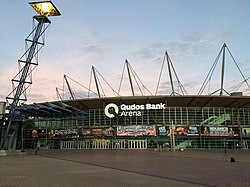
Canberra Stadium is a facility primarily used for rugby league, soccer and rugby union games, located adjacent to the Australian Institute of Sport in Canberra, the capital of Australia. It is the largest sports venue by capacity in Canberra.

Melbourne Park is a sports venue in the Melbourne Sports and Entertainment Precinct in Melbourne, Victoria, Australia. Since 1988, Australia's bicentenary, Melbourne Park has been home of the Australian Open Grand Slam tennis tournament, which is played annually in January. The park has facilities capable of hosting basketball, netball, music concerts and other events. In the past Melbourne Park has hosted ice skating, track cycling, international swimming and motorsport events.

Rod Laver Arena is a multipurpose arena located within Melbourne Park, in Melbourne, Victoria, Australia. The arena is the main venue for the Australian Open, the first Grand Slam tennis tournament of the calendar year.

Sydney Entertainment Centre was a multi-purpose arena located in Haymarket, Sydney, Australia. It opened in May 1983, to replace Sydney Stadium, which had been demolished in 1970 to make way for the Eastern Suburbs railway line. The centre was owned by the Sydney Harbour Foreshore Authority, which administered the neighbouring Darling Harbour area, and managed under a lease.
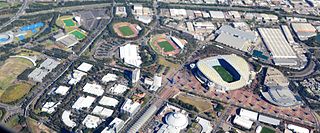
Sydney Olympic Park is a suburb of Greater Western Sydney, located 13 kilometres west of the Sydney central business district, in the local government area of the City of Parramatta Council. It is commonly known as Olympic Park but officially named Sydney Olympic Park. The area was part of the suburb of Lidcombe and known as "North Lidcombe", but between 1989 and 2009 was named "Homebush Bay". The names "Homebush Bay" and, sometimes, "Homebush" are still used colloquially as a metonym for Stadium Australia as well as the Olympic Park precinct as a whole, but Homebush is an older, separate suburb to the southeast, in the Municipality of Strathfield.

The Olympic Gymnastics Arena (Korean: 올림픽체조경기장), also known as the KSPO Dome since 2018, is an indoor arena located within the Olympic Park in Seoul, South Korea. It was constructed between 31 August 1984 and 30 April 1986, to host the gymnastics competitions at the 1988 Summer Olympics. It has a capacity of 15,000. The roof was designed by David H. Geiger. It is a self-supporting cable dome – the first of its kind ever built – with a four-layer fabric cladding.

The Adelaide Entertainment Centre (AEC) is an indoor arena located in the South Australian capital of Adelaide. It is used for sporting and entertainment events. It is the principal venue for concerts, events and attractions for audiences between 1,000 and 11,300.

Margaret Court Arena is a multi-purpose sports and entertainment venue located in Melbourne Park in Melbourne, Victoria, Australia. The arena, which was built in 1987 and redeveloped in the mid-2010s, has a capacity of 7,500.

Adelaide Arena is a multipurpose indoor sports stadium located in Findon, an inner western suburb of Adelaide, South Australia.

Hillsong Conference is a mid-year week long annual conference hosted in Sydney, Australia, with a smaller three day conference held in London later each year. It is the largest annual conference in Australia of any kind. The conference is hosted by Hillsong Church at the Qudos Bank Arena and surrounding Olympic Park precinct.

For the 2000 Summer Olympics, a total of thirty sports venues were used. After Melbourne hosted the 1956 Summer Olympics, Australia made several bids for the Summer Olympics before finally winning the 2000 Summer Olympics by two votes over Beijing, China. Venue construction was set at the Homebush Bay area of Sydney in an effort to rehabilitate the land. Environmental studies of the area in the early 1990s forced remediation to be used for about a fifth of the site selected. Fifteen new venues were constructed for the Games. Many of the venues used for the 2000 Games continue to be in use as of 2020, although some of the pre-existing facilities have been demolished and replaced.

The State Sports Centre is a multi-use indoor arena in Sydney, New South Wales, Australia and was opened in November 1984. With a total of 3,854 fixed and retractable seats the main arena is a focal point of the Sydney Olympic Park Sports Centre. An additional 1,152 portable seats can be accommodated on the floor level to bring seated capacity to 5,006.

The Sydney Olympic Park Tennis Centre is a tennis and multi-purpose sports facility located within the Olympic Park in Parramatta, near Sydney, Australia. The centre was built in 1999 and hosted the tennis events for the 2000 Summer Olympics. The venue hosted the Sydney International tournament from 2000 to 2019 and has hosted the ATP Cup since 2020. The main stadium in the centre is the Ken Rosewall Arena, which has a seating capacity of 10,500, and is capable of hosting multiple sports, including tennis and netball.

Perth Arena is a neofuturistic entertainment and sporting arena in the city centre of Perth, Western Australia, used mostly for basketball matches. It is located on Wellington Street near the site of the former Perth Entertainment Centre, and was officially opened on 10 November 2012. The Perth Arena is the first stage of the Perth City Link, a 13.5-hectare (33-acre) major urban renewal and redevelopment project which involves the sinking of the Fremantle railway line to link the Perth central business district directly with Northbridge.
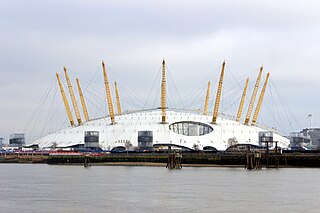
The O2 Arena, commonly known as the O2, is a multi-purpose indoor arena in the centre of the O2 entertainment complex on the Greenwich Peninsula in southeast London. It opened in its present form in 2007. It has the second-highest seating capacity of any indoor venue in the United Kingdom, behind the Manchester Arena, and in 2008 was the world's busiest music arena.
Qudos Mutual Limited, t/a Qudos Bank, is an Australian mutual bank that provides retail banking products and services including home loans, personal loans, car loans, credit cards, savings, financial planning assistance and foreign exchange.
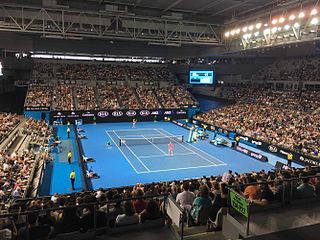
John Cain Arena is a multi-purpose sports and entertainment arena located within Melbourne Park in Melbourne, Victoria, Australia. It is the second-largest venue and show court for the Australian Open, the first Grand Slam professional tennis tournament held each calendar year. The arena also hosts various other sporting and entertainment events throughout the year.
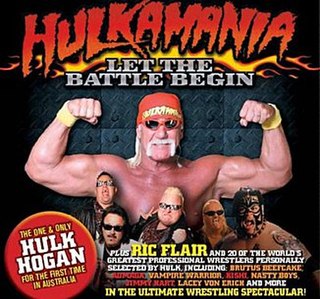
Hulkamania: Let The Battle Begin Tour was a 2009 professional wrestling tour promoted by Hulk Hogan and Eric Bischoff, which took place in Australia. These events featured the first wrestling appearance of Hogan in Australia. The event was taped by ONE HD.
